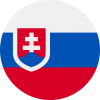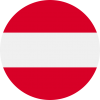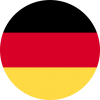Rules of traffic in Europe
Slovakia by rental car

Speed Limit
The speed limit on the roads in town or city is 50km/h, out of town 90 km/h and on the motorway 130 km/h.
Highways in Slovakia
There are four main motorways (all paid) in Slovakia.
D1 starts in Bratislava and finishes on the border in Vysne Nemecke.
D2 starts in Brodske and finishes in Rusovce.
D3 starts in Hricovske Podhradie and ends in Skalite.
D4 starts in Kittsee Jarovce and finishes on the border with Austria.
Road Payment, Highway Toll
It is necessary to have a toll sticker (vignette) if you want to drive on the motorway in Slovakia. The price of toll sticker for one year is 50 Euros. One month toll sticker is 14 Euros and 10 day toll sticker costs 10 Euros. You can buy the toll ticket in post offices and on the gas stations.
Gas Stations & Average Price for Gas in Slovakia
The average price for one liter of 95 fuel is around 1.50 Euro, for diesel a bit less.
The gas stations are available in towns or on the outskirts of the towns, next to motorways and roads and also in some villages. They are open from the morning till evening; many of them are open nonstop.
Driving under Influence, Fines for Speed
The fines for higher than allowed speed out of towns are:
Speed above allowed
For more than 20 km/h
For more than 30 km/h
For more than 40 km/h
For more than 75 km/h
Money penalty
cca 70 Euros (or more)
cca 100 Euros (or more)
cca 200 Euros (or more)
cca 800 Euros
The drivers may pay the fines with credit cards. If the policemen do not have terminal and the driver does not have enough cash with him, his driving licence card may be held.
There is zero tolerance to alcohol. The fine for alcohol use is from 200 to 1000 Euros and prohibition of driving for to five years. Driving under the influence of one per mille of alcohol or under the influence of other addictive substances and refusal of the tests is a crime. Drunk driver can face one year in prison.
It is obligatory to have car lights on all year.
Do not use your phone while driving a car, it is forbidden.
Winter on Roads
There are a lot of mountains pass overs on the roads from the south to the north of Slovakia. Very problematic (usually causing snarl-ups) are mountains Donovaly(Ruzomberok – Banska Bystrica), Velky Sturec (Martin – Banska Bystrica) and Certovica(Liptovsky Mikulás – Brezno). Try to avoid them in winter if possible.
If there is snow or glare ice, it is good to use tire chain, especially for trucks.
Austria by rental car

Mandatory Winter Equipment
In winter conditions the use of four winter tires or snow chains on at least two tires is now mandatory in Austria between 1 November and 15 April.
Snow chains are not required but must be carried in areas under advisory. Snow chains on summer tires – as an alternative to winter tires – are only accepted if the entire road is heavily covered with snow and no damage to the road is caused by the snow chains. These winter provisions are strictly enforced and control points are common.
You must display a Vignette on the inside of the windshield of your vehicle as you enter Austria. The vignette must be stuck to your windshield in order to be valid. Failure to do so will mean a heavy, on-the-spot fine. Stickers can be obtained from the Austrian Automobile Clubs as well as post offices, newsagents and petrol stations. You can also purchase stickers in Austria’s neighboring countries at petrol stations, borders and Automobile Clubs.
Toll Sticker Prices 2017:
| Type of vehicle | 10-day-toll sticker | 2-month-toll sticker | Annual toll sticker |
| Vehicle with a maximum gross vehicle weight of up to 3.5 t | € 8,90 | € 25,90 | € 86,40 |
| Motorcycle | € 5,10 | € 13,00 | € 34,40 |
The toll tariff system based on emission categories concerns all motor vehicles with a maximum permissible gross weight exceeding 3.5t and applies on all Austrian motorways and highways. These vehicles are required to attach a small adjustment – named the GO-Box – to their windscreen. Note that this includes larger private vehicles such as motor caravans that are above the weight limit. If your motor vehicle is close to the weight limit you are advised to carry documentation confirming the maximum permitted laden weight. If your registration documents do not clearly state this, you’ll need to produce alternative certification e.g. from a weigh-bridge.
Drink Driving Limits
The legal drink driving limit in Austria is 50 milligrams of alcohol in 100 millilitres of blood (the limit is10 milligrams of alcohol in 100 millilitres of blood if you have had your licence for two years or less and for coach and HGV drivers). Penalties for driving under the influence are severe.
Speed Limits
| Urban kph (mph) | Open Road kph (mph) | Motorway kph (mph) | |
| Car | 50 (31) | 100 (62) | 130 (81) |
| Towing | 50 (31) | 80 (50) | 100 (62) |
| Motorcycle | 50 (31) | 100 (62) | 130 (81) |
Get Visible
High visibility warning vests are required for all drivers. They need to be stored within reach of the driver and must be worn day or night when exiting the vehicle on the hard shoulder or in the event of breakdown. You must also have a first aid kit and a warning triangle inside the car in case you break down. Only ‘hands free’ mobile telephones can be used whilst driving.
Fuel
All grades of unleaded petrol, diesel and LPG are available as well as lead substitute additive. It is allowed to carry petrol in a can. Credit and debit cards are widely accepted, although they probably won’t work at automatic pumps. At many garages in rural areas only automatic pumps are available at lunch time, during the evening and weekend, so make sure you’re topped up.
Parking
For short-term parking (Kurzparkzone) you must buy a ticket from a local shop and fill in your time of arrival. At night you must leave your sidelights on unless street lighting is provided.
Fines
On-the-spot fines are issued. Ensure an official receipt is issued by the officer collecting the fine.
Traffic Accident, Breakdown
Traffic accidents involving injury to persons must immediately be reported to the police; accidents involving material damage must only be reported when mutual identity has not been established. The ÖAMTC and ARBÖ Automobile Clubs operate a 24-hour emergency breakdown service, which may be utilized by anyone (non-members must pay a fee).
Emergency Numbers
Dial 112 anywhere in the EU to reach the emergency services.
Local Numbers:
- Fire – 122
- Police – 133
- Ambulance – 144
- Mountain Rescue – 140
- Doctor (out of hours) – 141
Driving in Germany

At all times
Always have in your car your driver’s license and International Driver’s Permit, car registration, insurance information, blue parking disk and emergency kit.
Speed limits
The standard speed limits are 50 km/h within the city limits and 100 km/h on rural roads, unless otherwise posted. The city limits are marked with a yellow sign which has the city name on it at the beginning of the city limits, and the same yellow sign with a red slash through it at the end of the city limits. When driving in the city, if you see a blue sign with white car, children and bike symbols on it, then you must drive at a walking speed.
The German Autobahn
On the Autobahn, you can drive as fast as you feel is safe; the German authorities recommend a “suggested” speed of 130 kmh (80mph).
You can only pass another car in the left lane. The right lane is for slower vehicles, and overtaking cars in the right lane is illegal.
Before you pull into the left lane to pass another car, make sure to check the rear view mirror carefully – some cars travel as fast as 200 kmh and approach very suddenly.
Speed control
Beware the cameras that will gladly take your picture if you are speeding – these cameras are in many areas along the Autobahn as well as in the cities.
Lane markings
Lanes going the same direction are separated by dashed white lines. A Solid white line separates the different directions. Yellow lines are to notate a change in the traffic flow in a construction area – not to separate the different sides of the road
Diving lanes
Stay in right lane whenever possible. After passing, go back to the right lane. The left lane should only be used for passing, especially on the Autobahn. If, while in the left lane, you see someone coming up behind you – get out of the way.
Passing
Traffic lights
Right on Red
You are not allowed to turn right on a red light. The only exception to this is when there is a specific signal with a green right arrow.
Traffic signs
These are usually posted on the right, so keep an eye out. The ADAC (the German national motor club) has made a very comprehensive list of traffic signs.
Right of way
When no traffic signal is at an intersection, follow these right of way rules: If you have a sign with a yellow diamond at an intersection, you have the right of way. If you have a sign which is a white triangle with a red border (yield sign), you must wait for the oncoming traffic to clear. If there is no sign, then a vehicle entering from the right has the right of way. There are no 3-way or 4-way stop signs. Likewise, there are also no flashing red lights. If you approach a flashing yellow light, proceed with caution – this does not automatically give you the right of way.
Merging
When merging, observe the “zipper rule” (Reißverschluß), which states that both lanes feed into the continuing lane, alternating cars from each lane. No one lane has priority over the other.
Pedestrian Crossings
Pedestrians crossing the street have the right of way, and you must stop for them. Also, when coming to a stop at an intersection, make sure you do not block the pedestrian crossing.
Traffic Jams
If you find yourself driving into a traffic jam, remember to turn on your hazard lights to warn the drivers behind you. (You can turn them off again once you have a few cars behind you.)
Stalled car
If something happens to your car that is not a serious accident, move it over as far as you can to the right, put your hazard and parking lights on, put your safety vest on and set the warning triangle 100 m (200 m on the highway) away from the car to warn oncoming traffic. Telephones are placed along the Autobahn in case assistance is needed.
Alcohol limit: 0.05%
Roadside Assistance Numbers:
Road Assistance ADAC +49 (0)1802 22 22 22
Road Assistance ACE +49 (0)711 530 34 35 36
Road Assistance AVD +49 (0)800 9909909
Driving in Poland

Some rules
Traffic is on the right side.
Maximun speed: 50 kmh in towns from 5 AM to 11 PM and 60kmh from 11 PM to 5 AM, 90 kmh outside urban areas, 110 kmh on dual carriageways and 130 kmh on motorways
Permitted alcohol content in blood is 0.2 promilles. Head lights must be used all year long.
Foreign drivers can use a driving license from their home country or an international driving license for up to six months after entering Poland. Afterwards they are obliged to pass the local examinations which presuppose the knowledge of the Polish language.
Seatbelts must be worn by both front seat and back seat passengers and it is prohibited to use hand-held mobiles while driving.
Children under 12 are obligated to sit in special child seats that should be installed on the back seat.
Cars must be equipped with a fire extinguisher, a first-aid kit and a hazard-warning reflexive triangle.
Information for drivers
Caution signs and plates explaining the type of obstacle and danger have a yellow background.
Pedestrians may use roads outside inhabited areas, where there is often poor visiblity.
Some roads are in a rather bad condition, despite the national renovation programme in progress.
There are a lot of unguarded railway crossings, which require the driver’s attention.
Buses moving from a bus stop have the right of way.
Trams enjoy the right of way at equivalent intersections.
Big Polish cities are full of roundabouts, and the traffic is often coordinated by the police. There are some streets where only taxis and coaches are permitted to enter.Drivers are not very cautious and Poland has one of the worst road accidents statistics in Europe.
Polish fines range from 50-500 PLN (for speeding).
Driving in Hungary

Driving is on the right side of the road and overtaking only on the left side.
The minimum age for driving in Hungary is 18.
For driving either a rented or own car, the Third Part insurance is obligatory.
Speed limits are depended by types of roads: in urban areas, it is 50 km/h (31 mph); for dual carriageways, it is 110 km/h (65 mph); on a motorway, it is 130 km/h (80 mph).
Hungary has a zero tolerance policy on drink driving.
For driving outside of urban area, dipped headlights at all times are required.
For driving on motorways, it is necessary to obtain a special sticker (vignette) which is available from petrol stations. Following roads require presence of a vignette: Budapest – Hegyeshalom; Budapest -Gorbehaza – Nyiregyhaza; Budapest – Kiskunfelegyhaza – Szeged – Roszke; M0- Erd – Dunaujvaros; Budapest – Lake Balaton – Letenye; Emod – Miskolc; Gorbehaza-Debrecen.
Drivers must always give way to public transports such as buses and trams.
It is required by law to have in a car: a first aid kit, reflective jacket, warning triangle, and spare headlamp bulbs.
While driving, it is illegal to use cell phone; drivers may use only phones with hands- free systems.
Seatbelts are mandatory for a driver and all passengers from front and rear seats.
Children who are less than 150 cm tall must sit in the back seat. Children under three years of age must have an appropriate child seats.
Drivers may only use horns in cases of extreme danger.
Foreign drivers must have at all time while driving their original driving permits, International driver licenses, passports, car registration and insurance certificates.
Parking is permitted on the right-hand side of two-way streets and on both sides of one-way streets. Yellow line at side of road means no stopping
It is a rule to yield to the car coming from right.
The police phone number is 107.
FAQ
RUNWELL car rental office is located in the very centre of Prague, 200 meters from the Wenceslas Square, in the same building where our rental cars are based. The full office address is Wilsonova 6, Prague 1.
Having finalised the documents for car rental, you will have the car ready within a few minutes. Unless you request a different return place at the time of ordering the car, you are expected to return the car in the office at the time specified in the contract. Be reminded that car delivery within Prague is free of charge, whereas the cost of car delivery to the Vaclav Havel international airport is EUR 20. For more information about car delivery and return in other cities of the Czech Republic and Europe please refer here.
There are several ways to park a car in Prague overnight without risking to violate parking rules of the Czech capital. The easiest way is to arrange parking in the hotel where you stay. If the hotel is located in the city centre or nearby, most likely it will be an extra charged service. If you are accommodated further out in the outskirts, then perhaps parking will be free of charge. Parking in the city allows you to park the car overnight in certain places marked by a white dotted line: even though from 6, 8 or 24 pm until 8 am parking is very often for free, please pay attention to the signs. It is important to bear in mind that you must not leave the car on the blue line because those parking places are reserved exclusively for Prague residents. For our customers who have rented a car from RUNWELL company we provide a possibility to park in our parking lot in the centre of Prague at a special price of EUR 10 per day.
Yes, you can return the car whenever you wish. It is a free service for our clients during working hours, i.e. between 8 am and 8 pm, whereas returning the car outside those hours, i.e. between 8 pm and 8 am will be charged extra. In case of an earlier car return the rental fee is not refunded, unless otherwise agreed.
Car return should be executed exactly at the time specified in the contract. If your plans change and you wish to prolong the car rental period, it is worth informing us in advance. Depending on the schedule of your car booking by next customers we shall either extend its rental period or exchange your car for another vehicle. It is important to note that in this case the cost of car hire will be calculated according to the “flexible tariff, when the rental cost per day decreases depending on the number of rental days + the cost per one extra day”. In other words, renting a car in Prague for 4 days will end up being cheaper than car rental for 3 days plus an extension by one more day.
Should the client be late with car return at the time specified in the contract, fail to inform RUNWELL company in advance and not answer phone calls, then in addition to the cost of an extra day of rent, RUNWELL company is entitled to impose a fine starting from CZK 1000. If the car is not returned within three days after the date of expected return specified in the contract, the car is considered stolen and the police of the Czech Republic take over the investigations and the car search.
RUNWELL rent a car
Do you need a car rental in Prague? We offer new rental cars at the best price for our customers that they received the best rent a car experience in our country. You can pick up the car in Prague and plan your trip to see the cities and towns along with the most beautiful natural spots across the Czech Republic and all around Europe. RUNWELL is a low cost hire car company in the centre of Prague with free delivery and no hidden fees. We provide all include rent a car service every day from 8.00 till 20.00. Simple, easy and reliable rent a car in Prague with RUNWELL.
The benefits
- Experience and professionalism
- Vehicle collection
- New cars with A/T and M/T
- Easy to rent
- Flexible prices
- All inclusive
- Prague Center
- Non-stop hot line
- Workday from 8.00 till 20.00.
Contacts
- Wilsonova 6, Prague 1 11000, Czech Republic
- + 420 728 500 100
- info@runwellrentacar.com